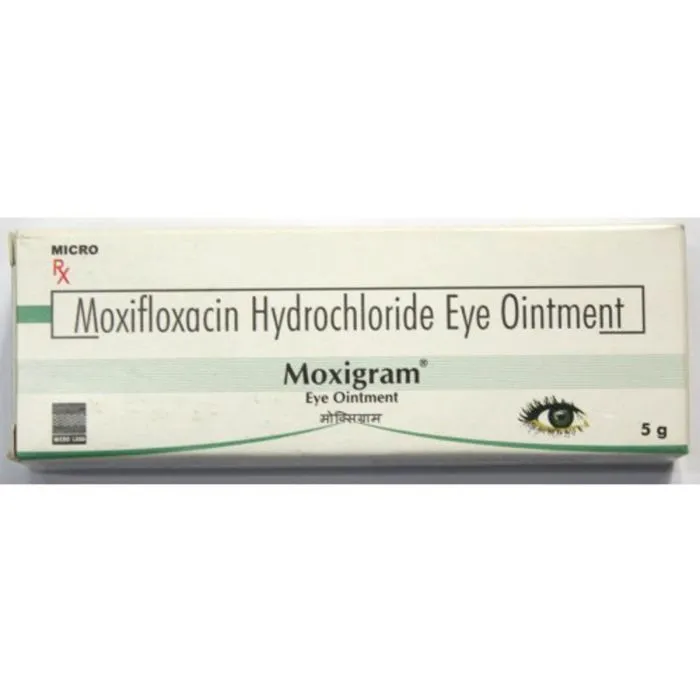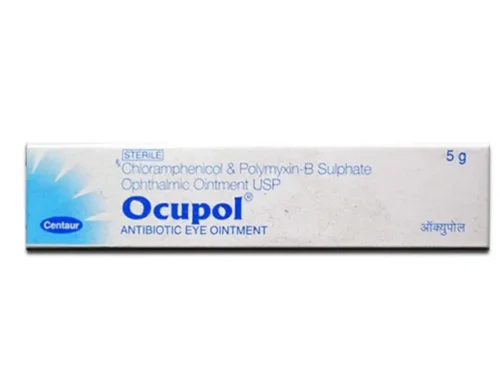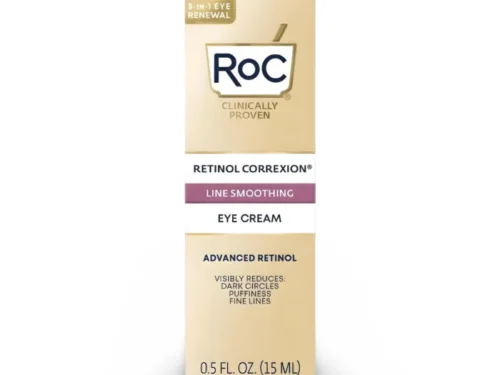Moxigram 5 gm
Moxigram 5 gm is an ophthalmic antibiotic eye ointment containing moxifloxacin.
Price range: $15.40 through $44.40
Availability: IN STOCK
Moxigram 5 gm is an eye ointment that contains moxifloxacin, which is an antibiotic. It treats bacterial eye infections like bacterial conjunctivitis and some superficial ocular infections with the help of a doctor. Moxifloxacin is a fourth-generation fluoroquinolone that works well against a wide range of bacteria and can get into the eye tissue well.
Key Features
| About Moxigram 5 gm | |
|---|---|
| Drug Class | Antibiotic |
| Subclass | Fluoroquinolone |
| Product Details | |
|---|---|
| Composition | Active ingredient:
Moxifloxacin Hydrochloride, Dexamethasone (if included in combination form). Inactive ingredients:
|
| Packaging Type | Tube |
| Pack Size | 5 gm |
| Dosage | Apply a small amount of Moxigram 5 gm around the affected eye area twice daily, or as directed by your physician. |
| Therapeutic Class | Ophthalmic Anti-infectives |
| Action Class | DNA Gyrase & Topoisomerase IV Inhibitor |
| Chemical Class | Fluoroquinolone derivative |
| Manufacturer | Ajanta Pharma |
| Shelf Life | 2–3 years from manufacturing date |
| Usages | Helps treat:
|
| Country of Origin | India |
| Storage | Store at room temperature (15–30°C), away from moisture and direct sunlight |
How Moxigram 5 gm works
Moxigram 5 gm delivers moxifloxacin directly to the surface of the eye. Moxifloxacin works by blocking bacterial enzymes needed to copy DNA. Without these enzymes, bacteria die or stop multiplying. Applied topically, the drug concentrates at the site of infection. This allows fast, local action with minimal systemic exposure. Studies show topical moxifloxacin penetrates ocular tissues well, which helps its effectiveness in surface and superficial corneal infections.
Indications / Uses
Moxigram 5 gm is intended for topical use in the eye for bacterial infections when an ophthalmic antibiotic is appropriate. Common indications include:
- Bacterial conjunctivitis (pink eye) caused by susceptible organisms.
- Superficial corneal infections where an ointment formulation is suitable and clinician permits.
- As directed by an eye care professional for other localized ocular bacterial infections.
You should not use this medicine for viral or allergic conjunctivitis unless a clinician also prescribes this antibiotic. Clinical judgment is required for infected or complex wounds of the eye.
Dosage & How to Use
General steps (follow the product label and your clinician):
- Wash hands well.
- Tilt head back and pull down lower eyelid to make a small pocket.
- Squeeze a thin ribbon (small amount) of Moxigram 5 gm into the lower eyelid pocket. Do not touch the tube tip to the eye.
- Close the eye gently for a few seconds. Wipe away excess ointment with a clean tissue.
- Replace cap securely.
- Use for the full recommended course even if symptoms improve. Typical topical moxifloxacin regimens for solutions are three times daily; ointment dosing may differ—follow clinician directions or the label for Moxigram 5 gm.
You should avoid driving or tasks requiring clear vision immediately after application. Ointment can blur vision temporarily.
Expected Benefits
- Rapid reduction in bacterial load on the ocular surface.
- Broad activity against many common ocular pathogens.
- Local therapy limits systemic exposure.
- Ointment form can provide a longer contact time on the eye surface compared with a single drop.
- Useful when a clinician prefers an ointment vehicle (e.g., at night or to provide lubrication). Clinical trials of topical moxifloxacin show high cure rates for bacterial conjunctivitis.
Side Effects & Precautions
Common / expected local effects
- Temporary blurred vision right after application.
- Mild eye irritation, stinging, or local redness.
- Excessive tearing in some users.
Less common / important cautions
- Hypersensitivity: stop and seek care if signs of allergy occur (severe redness, swelling, rash).
- Do not share the tube with others to avoid cross-infection.
- Contact lenses: avoid wearing contacts during active infection unless advised by a clinician. Ointment residues can adhere to lenses.
- Systemic effects from topical ocular use are rare but report any unusual symptoms to your provider.
If symptoms worsen or vision deteriorates, stop use and contact the treating clinician immediately.
Interaction & Important Clinical Notes
- Topical ocular interactions are uncommon. However, if multiple eye products are used, wait several minutes between each to avoid washout.
- Combining strong absorptive ocular dressings or products is not typical for the eye; note that ointments can interact with contact lens wear.
- Use in infected or complicated ocular conditions should include infection control measures and may require systemic antibiotics or specialist care. Regular reassessment is important.
Pharmacokinetics (ophthalmic)
Topical moxifloxacin acts mainly at the ocular surface. Ocular pharmacokinetic studies show that moxifloxacin achieves good levels in corneal and conjunctival tissue compared with many older fluoroquinolones. Systemic absorption after topical eye use is low. This profile supports strong local action with limited systemic exposure.
Clinical Evidence
Randomized clinical trials of topical moxifloxacin solution have demonstrated good clinical and microbiological cure rates in bacterial conjunctivitis versus placebo and noninferiority to some comparator antibiotics. Safety trials with nearly 2,000 patients reported an overall favorable safety profile for topical moxifloxacin. Evidence supports moxifloxacin’s speed of kill against common conjunctival pathogens. Ointment-specific data are less common than solutions, so clinician guidance is key for ointment use like Moxigram 5 gm.
Storage & Handling
- Store at room temperature as per packaging.
- Protect from direct sunlight and extreme heat.
- Keep the tube cap closed to maintain sterility.
- Discard if sterility is compromised or if the solution becomes discoloured. Follow product labels for expiry and discard dates.
Practical Tips & Realistic Expectations
- Expect temporary blurring—avoid driving immediately after use.
- Ointment may be ideal for night-time application due to prolonged contact.
- If using other eye drops, apply drops first, wait 5–10 minutes, then apply ointment if both are prescribed.
- Complete the recommended course even if symptoms improve to reduce recurrence and resistance risk.
- If no improvement in 48–72 hours or symptoms worsen, re-evaluate with the clinician.
Conclusion
Moxigram 5 gm is a topical ophthalmic ointment that contains moxifloxacin and is used to treat bacterial eye infections under the supervision of a doctor. It has a wide range of antibacterial effects and gets into the eyes well. It is a good way to treat certain eye bacterial infections if you use it correctly and follow your doctor’s advice. Always do what the doctor who prescribed the medication says to do, and read the label for the correct dose and safety information.
FAQ’s
Q1. Can Moxigram 5 gm be used for viral pink eye?
No, viral conjunctivitis is not treated with antibiotics. Use is only for bacterial infection or when a clinician prescribes it alongside other care.
Q2. How soon will I feel better?
Many patients notice improvement in 48–72 hours with topical moxifloxacin, but follow-up is important if symptoms persist.
Q3. Can children use Moxigram 5 gm?
Pediatric use depends on age and product labelling. A clinician will advise appropriate dosing for children.
Q4. Will it affect my contact lenses?
You should avoid contacts during active infection and until a clinician clears you. Ointment residue may stick to lenses.
Q5. Is resistance a concern?
Like all antibiotics, resistance can occur. Clinicians choose agents based on likely pathogens and local resistance patterns. Use as directed to reduce risk.
References
DailyMed — Moxifloxacin ophthalmic solution / label information.
https://dailymed.nlm.nih.gov/dailymed/drugInfo.cfm?setid=fc88791b-24da-48a4-85f5-93a8af3d0b51
StatPearls — Moxifloxacin overview (NCBI Bookshelf).
https://www.ncbi.nlm.nih.gov/books/NBK599511/
Keating GM. Moxifloxacin 0.5% ophthalmic solution: review. PubMed.
https://pubmed.ncbi.nlm.nih.gov/21175242/
Robertson SM, et al. Ocular pharmacokinetics of moxifloxacin. PubMed.
https://pubmed.ncbi.nlm.nih.gov/16257309/
| Select Tube | 4 Tube, 8 Tube, 12 Tube |
|---|







Isabella Walker –
Similar to Vigamox. Used it for bacterial eye infection, and it cleared things up quickly